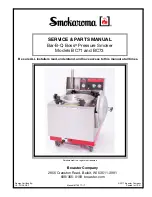
3
IMPORTANT SMOKE ALARM SITING
AND EXCEPTION INFORMATION:
•
The best place to put a smoke alarm is on the ceil-
ing. Install a smoke alarm as close to the centre of
the ceiling as possible. If this is not practical, mount
no closer than 30cm from a wall or corner.
Otherwise, if ceiling mounting is very difficult, you
may install smoke alarms on walls, between 15 and
30cm from ceiling/wall intersections, making sure
that the smoke alarm is above the level of any door
openings.
•
Install ceiling mounted smoke alarms at the highest point in the area at which smoke is likely to collect.
FIGURE 3: Wall Mounting of Smoke Alarms (Small Rooms and Short Hallways)
•
Site a smoke alarm in each room that is divided by a partial wall (either coming down from the ceiling at
least 20cm or coming up from the floor).
•
Site smoke alarms on peaked, cathedral, or gabled ceilings
90cm from the highest point (measured horizontally).
•
Site a smoke alarm in lived-in attics or attics which house electri-
cal equipment like furnaces, air conditioners, or heaters.
Where You Should Not Site Smoke Alarms
Do not site a smoke alarm within close proximity of heating and cooling supply vents or
within close proximity of return or fresh air vents. Smoke may be blown away from the
smoke alarm by the supply vents, or could be diffused or reduced by being diverted into the
return air vent.
Do not site your smoke alarm in an area where the temperature may fall below 5°C, or rise
above 45°C. Smoke alarms are designed to work safely only within these temperature
ranges, and failure to alarm, improper alarms, or nuisance alarms may result from operation
outside these temperature limits.
Do not site a smoke alarm in a damp or very humid area such as bathrooms with showers,
where the normal humidity may rise above 93% relative humidity. Above this level, moisture
may condense inside the smoke chamber and cause false alarms.
Do not site an ionisation smoke alarm in an area where particles of combustion are normally
present, such as kitchens or garages. An ionisation type smoke alarm with a FALSE ALARM
CONTROL feature or a photoelectric type smoke alarm should be used to minimize nuisance
alarms.
Do not site a smoke alarm in dusty or dirty areas—SUCH AN INSTALLATION CANNOT BE
RELIED UPON. An accumulation of dust and dirt in the sensing chamber may block the
openings and prevent an alarm, or may get inside the alarm and cause false alarms. If a
smoke alarm is required in such an area, vacuum it frequently and test it according to direc-
tions in
Maintenance and Cleaning
(page 5).
Do not site a smoke alarm in the dead air space in the corner where the wall meets the ceil-
ing. If in doubt as to the exact alarm siting, for your safety, contact your local fire brigade
for help in choosing a location.
Do not site a smoke alarm where bugs or insects are present before eliminating or minimiz-
ing the bug problem. Although all smoke alarms built since 1986 are made to prevent bugs
from entering the detection chamber, bugs may build up on chamber openings and prevent
smoke from entering. As a result, unit should be vacuumed frequently as explained in
Maintenance and Cleaning
(page 5).
Do not site a smoke alarm within close proximity of a fluorescent light. Electrical noise may
cause nuisance alarms.
Do not paint smoke alarm.
Do not install smoke alarms closer than 300mm to light fittings.
Do not install smoke alarms on surfaces that can become very hot or very cold, such as
poorly insulated external walls, or ceilings in houses with a ceiling heating system.
Do not mount a smoke alarm in such a position that it is difficult or dangerous to reach for
maintenance or battery replacement.
Do not site the alarm in an area where water or other liquids may enter the alarm.
90cm
PEAKED CEILING
1m
30cm
15cm
MINIMUM
30cm
MAXIMUM
CEILING
SIDE
WALL
ACCEPTABLE HERE
NEVER HERE
TOP OF DETECTOR
ACCEPTABLE HERE
150-300mm
SMOKE ALARM ABOVE
TOP OF DOOR OPENING
20cm
STUB WALL
SOFFIT
111-281 English new 7/25/01 4:24 PM Page 3

























